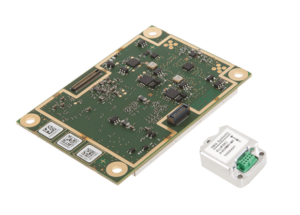 Septentrio, a developer of high-precision positioning technology, has announced that the company’s AsteRx-i S GPS/INS receiver is now available with a single antenna option. This single antenna receiver provides robust centimeter positioning and 3D attitude (heading, roll, pitch), while keeping weight and power consumption to a minimum. This new option means simplified integration and increased operation time and productivity for SWaP-conscious applications such as unmanned aerial vehicles (UAVs).
Septentrio, a developer of high-precision positioning technology, has announced that the company’s AsteRx-i S GPS/INS receiver is now available with a single antenna option. This single antenna receiver provides robust centimeter positioning and 3D attitude (heading, roll, pitch), while keeping weight and power consumption to a minimum. This new option means simplified integration and increased operation time and productivity for SWaP-conscious applications such as unmanned aerial vehicles (UAVs).
Septentrio’s centimeter-level positioning is based on multi-frequency, multi-constellation GNSS (GPS, GLONASS, Galileo, BeiDou, QZSS) technology. AsteRx-i S combines GNSS and an industrial-grade IMU (Inertial Measurement Unit) to deliver precise positioning together with 3D attitude and coasting functionality. Septentrio’s unique GNSS – IMU integration algorithm enables continuous positioning in difficult environments such as near high structures, under foliage or during short GNSS outages (this is referred to as coasting or dead reckoning). This makes AsteRx-i S an ideal positioning solution for robotics, autonomous vehicles and logistics.
Find suppliers of GPS/INS for unmanned applications >
“By strengthening our GPS/INS integration portfolio we continue building upon our strategy of bringing reliable precise positioning together with 3D attitude to challenging industrial environments such as container parks or tree plantations,” said Danilo Sabbatini, Product Manager at Septentrio. “AsteRx-i S has now become even more versatile with the support of both single and dual antenna operations on the same hardware platform. With the single antenna AsteRx-i S delivers accurate 3D attitude in small-size applications where weight and power consumption are critical, while the dual antenna option is still the best solution for applications requiring short initialization time.”
The single antenna AsteRx-i S requires minimal space which makes it ideal for robotic devices requiring small and light precise positioning solutions. Since only one antenna is required, there is less weight and lower power consumption, resulting in extended battery life. The dual antenna AsteRx-i S, on the other hand, is the best solution for devices requiring quick heading initialization and devices with prolonged static operation.
AsteRx-i S comes with built-in Advanced Interference Mitigation (AIM+) technology. In robotic devices neighboring electronics can emit electromagnetic radiation which interfere with GNSS signals. AIM+ offers protection against such interference resulting in faster set-up times and robust continuous operation. A built-in power spectrum plot allows users to analyze interference, helping locate its source and mitigating it.


















